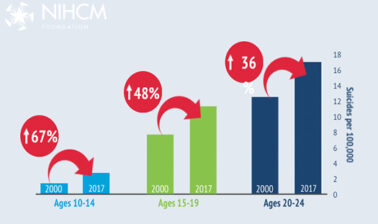Infographics
Mental Health: Trends & Future Outlook
Published on: November 11, 2019. Updated on: October 20, 2020.
About the Data Insights
This mental health infographic explores trends in mental health and their implications for the future. Mental illness has become more common over the last decade, with 1 in 5 adults experiencing mental illness in any given year. The overall growth is largely driven by higher rates of mental illness in 18- to 25-year-olds.
While new treatment options are emerging to meet diverse needs, treatment gaps persist due to stigma and barriers to access. Closing treatment gaps will require solutions to address workforce shortages, which are projected to worsen in the coming years.
Mental illness impacts a large portion of the population and the problem is growing
Prevalence of mental illness in 2008 and 2018:
- Any Mental Illness prevalence: SAMHSA, 2018 National Survey on Drug Use and Health. Table 10.1A – Any Mental Illness in Past Year among Persons Aged 18 or Older, by Demographic Characteristics: Numbers in Thousands, 2008-2018
- NOTE: Any Mental Illness can include anxiety disorders, psychotic disorders and symptoms, mood and adjustment disorders, emotional and behavioral disorders, eating disorders, and personality disorders.
- Serious Mental Illness statistic: SAMHSA, 2018 National Survey on Drug Use and Health. Table 10.3A – Serious Mental Illness in Past Year among Persons Aged 18 or Older, by Demographic Characteristics: Numbers in Thousands, 2008-2018
- NOTE: SAMHSA defines serious mental illness as someone over 18 having (within the past year) a diagnosable mental, behavior, or emotional disorder that causes serious functional impairment that substantially interferes with or limits one or more major life activities
The overall growth is largely driven by higher rates of mental illness in 18-25 year olds
Graph depicting trends in rates of mental illness, population total and aged 18-25: SAMHSA, 2018 National Survey on Drug Use and Health. Table 10.1B – Any Mental Illness in Past Year among Persons Aged 18 or Older, by Demographic Characteristics: Percentages, 2008-2018
Mental illness and chronic illness often co-occur, complicating the treatment for both
Statistics on co-occurrence of behavioral health disorders and chronic disease: Thorpe K; Jain S; Joski P. Prevalence and Spending Associated With Patients Who Have A Behavioral Health Disorder And Other Conditions. Health Affairs. Volume 36, No. 1. (January 2017)
Cost of co-occurrence of behavioral health disorders and chronic disease: Milliman Research Report: Potential Economic Impact of Integrated Medical-Behavioral Healthcare. Updated Projections for 2017.
- NOTE: The term “behavioral health conditions” is used to include mental health and substance use disorder
Evidence-based treatments are available, but there is no “one-size-fits-all” approach
Types of therapy options available: National Institute of Mental Health. Health Topics.
- NOTE: Types of therapies can include:
- Medication: anti-anxiety drugs, anti-depressants
- Psychotherapy: cognitive behavioral, interpersonal & psychodynamic therapy
- Complementary Strategies: stress management techniques, exercise & nutrition
Social Factors and Mental Health derived from: NAMI, Mental Health Conditions
Efforts to expand treatment options:
- Collaborative Care: SAMHSA-HRSA Center for Integrated Care Solutions, A Standard Framework for Levels of Integrated Healthcare. 2013.
- Peer Supports: SAMHSA, Integrating Peer-support Services
Addressing treatment gaps will be key as supply and demand makes the problem worse
Graph depicting treatment gaps:
- Treatment for Adults with Mental Illness: SAMHSA, 2018 National Survey on Drug Use and Health. Table 10.9B – Received Mental Health Services in Past Year among Persons Aged 18 or Older with Past Year Any Mental Illness, by Demographic Characteristics: Percentages, 2008-2018
- Treatment for Adults with Serious Mental Illness: SAMHSA, 2018 National Survey on Drug Use and Health. Table 10.11B – Received Mental Health Services in Past Year among Persons Aged 18 or Older with Past Year Serious Mental Illness, by Demographic Characteristics: Percentages, 2008-2018
Percent of Americans in a Mental Health Care Health Professional Shortage Area calculated using:
- Kaiser Family Foundation, Mental Health Care Health Professional Shortage Areas (HPSAs)
- US Census, Quick Facts
Supply and Demand: HRSA Health Workforce, State-Level Projections of Supply and Demand for Behavioral Health Occupations: 2016-2030. September 2018.
More Related Content
See More on: Behavioral Health | Social Determinants of Health

